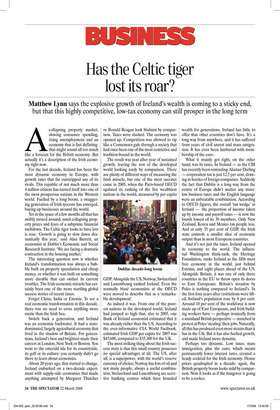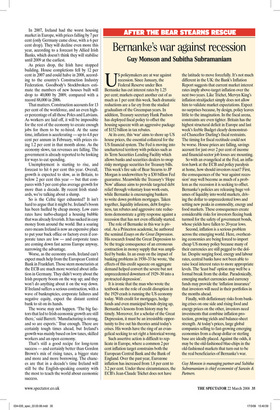Has the Celtic tiger lost its roar?
Matthew Lynn says the explosive growth of Ireland’s wealth is coming to a sticky end, but that this highly competitive, low-tax economy can still prosper in the long term Acollapsing property market, slowing consumer spending, rising unemployment and an economy that is fast deflating: that might sound all too much like a forecast for the British economy. But actually it’s a description of the Irish economy right now.
For the last decade, Ireland has been the most dynamic economy in Europe, with growth rates that far outstripped any of its rivals. This republic of not much more than 4 million citizens has turned itself into one of the most prosperous nations in the Western world. Fuelled by a long boom, a swaggering generation of Irish tycoons has emerged, buying up businesses around the world.
Yet in the space of a few months all that has swiftly turned around, amid collapsing property prices and fears of a subprime financial meltdown. The Celtic tiger looks to have lost is roar. ‘Growth is going to slow down dramatically this year,’ said Alan Barrett, an economist at Dublin’s Economic and Social Research Institute. ‘We are facing a dramatic contraction in the housing market.’ The interesting question now is whether Ireland’s transformation was always a bubble built on property speculation and cheap money, or whether it was built on something more durable that can outlast its current troubles. The Irish economic miracle has certainly been one of the more startling global success stories of recent times.
Forget China, India or Estonia. To see a real economic transformation in this decade, there was no need to cross anything more exotic than the Irish Sea.
Switch back a generation, and Ireland was an economic backwater. It had a statedominated, largely agricultural economy that lived in the shadow of Britain. For generations, Ireland’s best and brightest made their careers in London, New York or Boston. You went to the emerald isle for its countryside, its golf or its culture: you certainly didn’t go there to learn about economics.
About 20 years ago, that started to change. Ireland embarked on a two-decade experiment with supply-side economics that made anything attempted by Margaret Thatcher or Ronald Reagan look Stalinist by comparison. Taxes were slashed. The economy was opened up. Competition was allowed to rip like a Connemara gale through a society that had once been one of the most restrictive and tradition-bound in the world.
The result was year after year of sustained growth, leaving the rest of the developed world looking tardy by comparison. There are plenty of different ways of measuring the Irish miracle, but one of the most succinct came in 2005, when the Paris-based OECD updated its ranking of the five wealthiest nations in the world, measured by per capita GDP. Alongside the US, Norway, Switzerland and Luxembourg ranked Ireland. Even the normally blasé economists at the OECD were moved to describe that as a ‘remarkable development’.
As indeed it was. From one of the poorest nations in the developed world, Ireland had jumped so high that, also in 2005, one Bank of Ireland economist estimated that it was already richer than the US. According to the ever-informative CIA World Factbook, estimated Irish GDP per capita for 2007 was $45,600, compared to $35,300 for the UK.
The most striking thing about the Irish success story is that this small country possesses no special advantages at all. The US, after all, is a superpower, with the world’s reserve currency of choice; Norway has lots of oil and not many people, always a useful combination; Switzerland and Luxembourg are secretive banking centres which have hoarded wealth for generations. Ireland has little to offer that other countries don’t have. It’s a long way from anywhere, and it has suffered from years of civil unrest and mass emigration. It has even been lumbered with membership of the euro.
What it mainly got right, on the other hand, was its taxes. In Ireland — as the CBI has recently been reminding Alastair Darling — corporation tax is just 12.5 per cent, drawing in hordes of foreign companies. Suddenly the fact that Dublin is a long way from the centre of Europe didn’t matter any more: low business taxes and the English language were an unbeatable combination. According to OECD figures, the overall ‘tax wedge’ in Ireland — the proportion of income taken up by income and payroll taxes — is now the fourth lowest of its 30 members. Only New Zealand, Korea and Mexico tax people less. And at only 35 per cent of GDP, the Irish state controls a smaller slice of economic output than in most European countries.
And it’s not just the taxes. Ireland opened its economy to the world. The influential Washington think-tank, the Heritage Foundation, ranks Ireland as the fifth most free economy in the world, just behind Estonia, and eight places ahead of the US. Alongside Britain, it was one of only three countries in the EU to throw open its doors to East Europeans. Britain’s invasion by Poles is nothing compared to Ireland’s. In the first four years after restrictions were lifted, Ireland’s population rose by 8 per cent. Around 10 per cent of the workforce is now made up of East Europeans, and Irish building workers have — perhaps ironically from a mainland British perspective — marched in protest at Poles ‘stealing’ their jobs. Naturally, all this has produced even more strains than it has in the UK. But it has also fuelled growth, and made Ireland more dynamic.
Perhaps too dynamic. Low taxes, mass immigration, plus the euro, which meant permanently lower interest rates, created a heady cocktail for the Irish economy. House prices quadrupled in a decade: again, the British property boom looks mild by comparison. Now it looks as if the hangover is going to be a corker. In 2007, Ireland had the worst housing market in Europe, with prices falling by 7 per cent (only Germany came close, with a 6 per cent drop). They will decline even more this year, according to a forecast by Allied Irish Banks, which doesn’t think they will stabilise until 2009 at the earliest.
As prices drop, the Irish have stopped building. House completions fell by 12 per cent in 2007 and could halve in 2008, according to the country’s Construction Industry Federation. Goodbody’s Stockbrokers estimate the numbers of new houses built will drop to 40,000 by 2009, compared with a record 88,000 in 2006.
That matters. Construction accounts for 13 per cent of the workforce, and an even higher percentage of all those Poles and Latvians. As workers are laid off, it will be impossible for the rest of the economy to create enough jobs for them to be re-hired. At the same time, inflation is accelerating — up to 4.8 per cent per annum in February, with prices rising 1.2 per cent in that month alone. As the economy slows, tax revenues are falling. The government is already reported to be looking for ways to cut spending.
Unemployment is starting to rise, and forecast to hit 6 per cent this year. Overall, growth is expected to slow, as in Britain, to below 2 per cent this year — but that compares with 5 per cent-plus average growth for more than a decade. By recent Irish standards, we’re talking about a slump.
So is the Celtic tiger exhausted? It isn’t hard to argue that it might be. Ireland’s boom has been fuelled by cheap money. Low euro rates have turbo-charged a housing bubble that was already feverish. It has sucked in easy money from around the world. But a soaring euro means Ireland is now an expensive place to put your back office or factory even if corporate taxes are low — and corporate taxes are coming down fast across Europe anyway, narrowing the advantage.
Worse, as the economy cools, Ireland can’t expect much help from the European Central Bank in Frankfurt. Those stern monetarists at the ECB are much more worried about inflation in Germany. They didn’t worry about the Irish property boom on the way up; and they won’t do anything about it on the way down. If Ireland suffers a serious contraction, with a wave of bankruptcies, corporate failures and negative equity, expect the distant central bank to sit on its hands.
The worse may not happen. ‘The big factors that led to Irish economic growth are still there,’ said Barrett. ‘Manufacturing is strong, and so are exports.’ True enough. There are certainly tough times ahead, but Ireland’s growth was mainly based on low taxes, skilled workers and an open economy.
That’s still a good recipe for long-term success — and certainly better than Gordon Brown’s mix of rising taxes, a bigger state and more and more borrowing. The chances are that in a decade’s time Ireland will still be the English-speaking country with the most to teach the world about economic success.



















































































 Previous page
Previous page